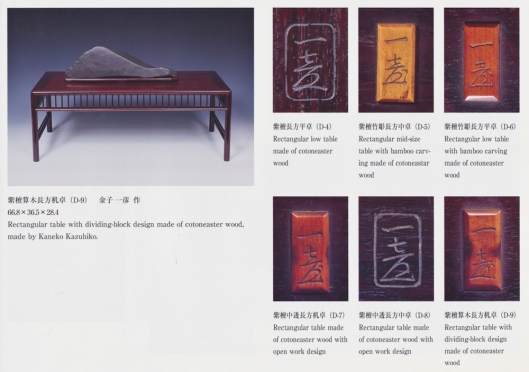Tags
We don’t know about you but we find it very difficult to find the right stand for our displays. Finding them in America often requires us to search eBay, local antique shops or a few online antique search engines. Yet, these often turn up very little. It is difficult because often a stand must be purchased just for a single display – much like high quality pots, they have to be right for what they are being matched with in the display.
We have been fortunate to find a number of stand that work with our small pots and stones, but it is an endless search assisted by our friends in Japan. Next as you know then there is the difficulty of getting them to the U.S. Small stands tend not to be a problem but larger stands often arrive with broken legs. Well, let’s know go down this path this morning. Many older and antique stands served other purposes than being the foundation for a bonsai or suiseki display. However, in the late 1950’s craftsmen began to be asked by bonsai and suiseki proprietors to make stands that suited their needs. Let’s take a few minutes to discover a few of these craftsmen.
Kaneko Kazuhiko and Tables
In 1959, Toshiji Yoshimura of Kofu-En Bonsai Garden gave orders to Kaneko Kazuhiko (1909-1972), a tropical wood craftsman, to make tables for bonsai and suiseki. Kaneko presumed a strong sturdy table would be appropriate for the display of bonsai and suiseki. He sat on the table he had made and claimed, “It can even hold me up.” Toshiji replied, “This will be used to display bonsai and stones. Please consider the size and thickness of the legs so that they will coordinate with the bonsai and stones.” In this way Toshiji taught Kaneko about the essentials of bonsai and stones. Kaneko had refined techniques in woodwork, and with guidance by Toshiji, he was able to complete a table for bonsai and suiseki in short time.
The tables (D-5, D-6) evoking a fresh atmosphere as if they were assemblies of natural bamboo, are made out of cotoneaster wood. To make these, Kaneko went to Baji Koen (a horse-park in Setagaya district) to sketch bamboo. The tables (D-7, D-8) with open work design were made with reference to ideas from other bonsai/suiseki enthusiasts. Kaneko spent time in formulating the design. The tables, created by the combination of the plans by Toshiji, who was aware of the essentials of bonsai and suiseki, and the refined techniques of Kaneko, enhance the beauty of the stones.
Kaneko passed away at the age of 70, when his skills were at zenith, capable of producing refined tables. The inscription “Kazuhiko” was inscribed underneath the top board of his tables. In the early days of when he was making his tables, he engraved his inscription directly on the bottom of the top board, but in later years, he followed Katsuragi Kozan’s way of attaching a bamboo with inscription. He similarly attached a piece of boxwood with his inscription to the table.
Kozan, Yuzan, and Junzan
Ogawa Yuzan (D-11) and Hibino Ikkansai are the oldest names of table craftsman known since tables for bonsai and suiseki started to be made at the end of the Meiji period. They followed by Katsuragi Kozan, and Shirai Junzan (Eisaku) (D-12), apprentice of Ogawa Yuzan (Seigo), Kaneko Kazuhiko, Nakano Teizan, and Hongo Junzan are the latest known craftsman and were active when the bonsai and suiseki boom was at its height.
Sugimoto Sashichi
This is a set of three tables designed and order made by Sugimoto Sashichi known as an enthusiast of shohin bonsai.
In Closing
All of these stands are beautifully made by superb craftsmen. I think we in America has a lot to learn by studying these tables. As we look at the above table by Sashichi (D-15) for what do you believe it was designed? At 88 x 25.6 x 4 cm it was likely created for a suiseki display. The low profile would be excellent for a long and relatively narrow bronze doban. That is not to say that a beautiful forest planting might not be held on this stand.
Clearly a great deal of thought was put into the creation of these tables. The woods are beautiful and selected for both their beauty of grain as well as their ability to harmonize with the intended objects to be displayed. I find with many American stands, the design is too heavy. As Toshiji Yoshimura stated above – the designer needs to pay particular attention to the thickness and size of the legs. Otherwise, there is a lack of harmony between the stand and the tree or stone being displayed.
Wouldn’t it be wonderful for someone in America who has the talent in woodworking to recreate these beautiful tables for us? The designs are timeless. The time that it would require to replicate these tables would dictate a tidy sum of money to acquire them but worth the cost. We hope you enjoy these tables this Sunday morning, or whenever you are reading this post.
Lastly, we want to thank Sen-En-Kyo for this valuable information on these superb tables. If you don’t have his book, I highly suggest you find a copy of Suiseki – An Art Created By Nature. You can find a reference to these books on our blog.









Beautiful craftsmanship. Thanks for sharing!